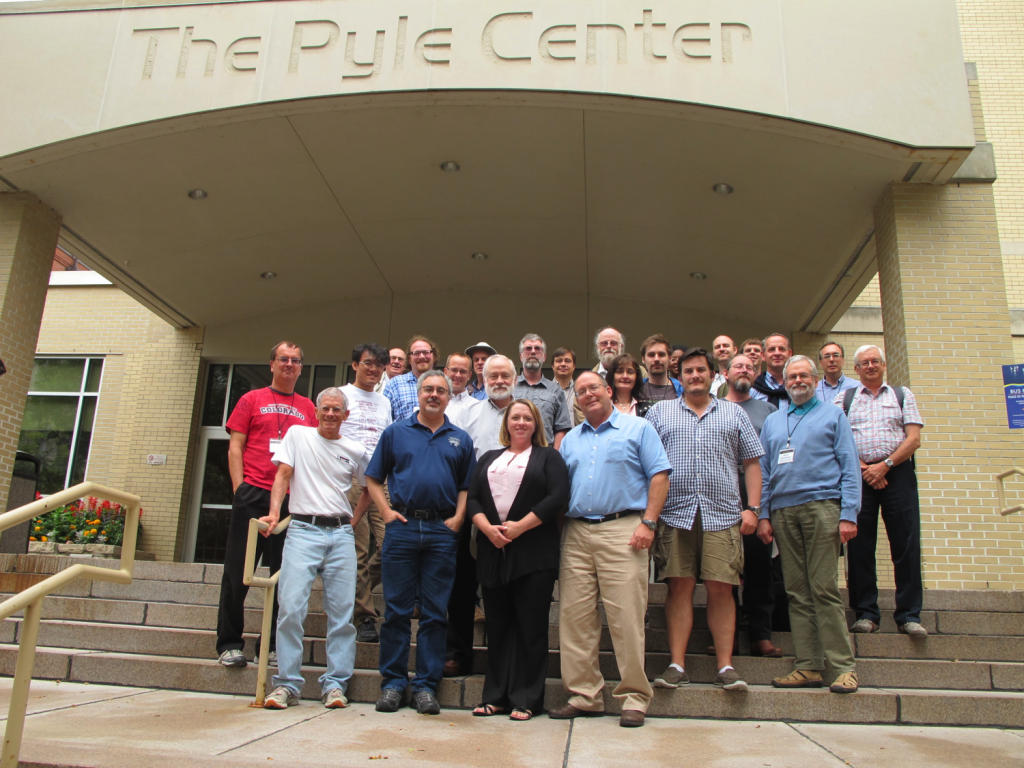UW-Madison hosts Saturn Science Conference: Saturn in the 21st Century
Scientists at the Space Science and Engineering Center (SSEC) at the University of Wisconsin-Madison, and other authors of “Saturn in the 21st Century,” a book set to be published by Cambridge University Press July 2016, met to discuss the depth and range of developments in Saturn research at the Saturn Science Conference held in Madison August 4-7, 2014.
Throughout the four-day conference, presenters covered all things Saturn, including the formation of Saturn and its atmosphere; the chemistry, composition, and thermal structure of the atmosphere; the planet’s interior structure, magnetic field, and rotation rate; and planetary weather, such as storm clouds and “ring rain.”
Conference Chair Kevin Baines, a researcher with SSEC and NASA’s Jet Propulsion Laboratory at the California Institute of Technology, summarized “the future exploration of Saturn” on the final day of the conference, by giving a timeline for the before, during, and after the Cassini-Huygens mission. Cassini-Huygens is an unmanned Saturn-observing spacecraft launched by NASA in 1997.
While the Cassini mission is expected to conclude in late 2017, future missions and probes are likely to take decades to launch. This gap poses a problem for those wishing to study Saturn — although there are several ongoing projects around the globe, such as NASA’s proposed New Frontiers Saturn Probe and the long-term Cosmic Vision from the European Space Agency.
To circumvent this foreseeable lapse, Baines emphasized reliance on ground-based facilities, to view the planet from Earth using telescopes, instruments, and imaging technology.
“We need to look at what we should do, what we can do, from the ground,” he said.
He also discussed the possibility of leveraging other missions, designed with different research initiatives in mind, which might pass by Saturn or otherwise have Saturn-observing capabilities. Juno, a NASA spacecraft launched in 2011, will map Jupiter’s water with a microwave device when it reaches the planet in June 2016. So, Baines posed the question, “Why not Saturn?”
In some cases, though, probes are the best way to go. Baines explained that, to find elemental abundances—the amounts of noble gasses, methane, or carbon, for example, that are present — on Saturn and Jupiter, they need probes, or perhaps specialized balloons in the future, since those molecules are located far within the planets and their atmospheres.
This need is something scientists learned from the Galileo Mission, specifically, the Galileo Probe dropped off by its Orbiter, which orbited Jupiter in the 1990s and into the 21st century.
“We are grateful to Galileo,” Baines said, “because one of the things it showed us is that meteorological features are not shallow; they go deep.”
It takes more than getting below the clouds to measure the composition of the atmosphere, Baines said. For example, probes have a hard time sending out signals from the “sweet spot” below Saturn’s clouds where gases are uniformly mixed and can be measured accurately. On Saturn, a cold and relatively low-gravity planet, clouds form at much greater depths than, say, Jupiter, and radio-absorbing gases are abundant.
SSEC scientist Larry Sromovsky’s important work on the composition of Saturn’s storm clouds, which he summarized in a presentation at the conference called “The Great Storm of 2010-2011 and Beyond,” came from the Cassini-Huygen mission. The “great storm” in question, according to Sromovsky, “lofted deep atmospheric aerosols up to the visible cloud tops, exposing to remote observation normally hidden materials produced at great depths.”
Currently, the scientific priorities in Saturn research, said Baines, are (in order, with some leeway) gravity, the planet’s magnetic field, thermosphere composition, and turbulence and small scales, each of which has a specific instrument in place to study it (RSS, MAG, INMS, RADAR, and ISS, respectively). Saturn’s ionosphere, internal magnetic field, Aurora, and lightning are other major areas of interest.
Overall, Baines’ talk provided an opportunity for conference-goers to get updates, ask questions, and share techniques with other members of the planetary research community. In one instance, in a conversation about the Saturn Atmospheric Entry Probe Mission, pushed back to 2033, attendees troubleshot possible drawbacks of the probe entering on Saturn’s night side, the side facing away from Earth (for one, observers on the ground would not be able to see it go in).
While mostly populated by scientists who study Saturn, the conference was also open to the public, and amateur observation by citizen scientists was emphasized in some of the talks.
For example, in 2009, citizen scientists saw a small asteroid collide with Jupiter, according to Baines. Amateurs were also the first to observe the eruption of the Great Storm of 2010-2011, the largest-ever single convective storm, he said, and their images were crucial to understanding the storm’s early development.
Baines concluded that numbers in the amateur community, and the quality of their work, is expected to grow, thanks in part to newer, better cameras and other technological improvements.
“There’s some neat stuff amateurs are doing,” he said. “As we’ve seen, they have already proved themselves to be valuable at observing Saturn.”
In addition to discussing ongoing and proposed research, attendees focused on efforts to organize and refine the in-progress book. The event page for the conference, with a PDF of all presented abstracts, may be found at: http://go.wisc.edu/953l0a
by Sarah Witman


